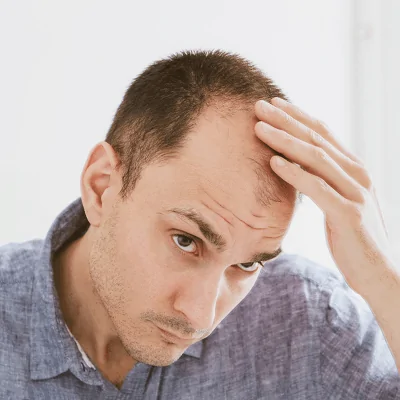Exploring Finasteride for Effective Hair Loss Treatment
- Huda Batool
- Dec 21, 2024
- 4 min read
Hair loss is a common concern for both men and women, and it often leads to a loss of confidence and self-esteem. While there are numerous treatments available, one of the most widely recommended options for treating male-pattern baldness and certain types of hair loss in women is Finasteride for Hair Loss Dubai This article explores the effectiveness of Finasteride in managing hair loss, its benefits, potential side effects, and how it can be a viable solution for many individuals struggling with thinning hair.
What is Finasteride?
Finasteride is a medication that was originally developed to treat benign prostatic hyperplasia (BPH), a condition that causes an enlarged prostate in men. However, during clinical trials, it was found to have the side effect of preventing hair loss, particularly in those with male-pattern baldness. Since then, it has become one of the most commonly prescribed medications for treating hair loss.
The drug works by inhibiting the enzyme 5-alpha reductase, which is responsible for converting testosterone into dihydrotestosterone (DHT). DHT is a hormone that plays a crucial role in hair loss, particularly in genetically predisposed individuals. By reducing DHT levels, Finasteride helps slow down hair loss and even promotes hair regrowth.
How Does Finasteride Work?
Male-pattern baldness is largely driven by the action of DHT on hair follicles, particularly those on the scalp. DHT binds to hair follicles, causing them to shrink and eventually stop producing hair. Finasteride reduces the levels of DHT in the scalp by blocking the enzyme 5-alpha reductase. With less DHT circulating, the hair follicles are less likely to shrink, thereby slowing down hair loss and encouraging the growth of thicker, healthier hair.
For women, Finasteride can also be effective in treating hair loss caused by hormonal imbalances, though it is typically prescribed off-label, as the drug is not FDA-approved for use in women, especially those who are pregnant or could become pregnant.

Benefits of Finasteride for Hair Loss Treatment
Proven Effectiveness: Numerous studies have shown that Finasteride is effective in treating male-pattern baldness. Approximately 60-80% of men who use Finasteride experience a stabilization of hair loss or even regrowth within the first year of treatment.
Non-Surgical Solution: One of the major advantages of Finasteride is that it is a non-invasive, easy-to-use treatment. Unlike hair transplants or other surgical interventions, Finasteride is a simple oral medication that can be taken daily.
Regrowth of Hair: In addition to preventing further hair loss, Finasteride can also help with the regrowth of hair. Many users report seeing thicker and denser hair after several months of consistent use.
Long-Term Results: The effects of Finasteride are not temporary. As long as the medication is used regularly, its effects can last for several years. However, stopping the treatment can lead to the resumption of hair loss within a few months.
Potential Side Effects of Finasteride
As with any medication, Finasteride is not without its potential side effects. While the majority of people experience no significant issues, some individuals may face adverse reactions, including:
Sexual Side Effects: Some men report decreased libido, erectile dysfunction, or reduced semen volume while taking Finasteride. These side effects are usually reversible upon discontinuation of the medication, but they can be concerning for some users.
Hormonal Changes: Because Finasteride works by altering hormone levels, it may cause breast tenderness, enlargement, or other hormonal disturbances in some individuals.
Psychological Effects: There have been reports of mood changes, including depression and anxiety, in some users of Finasteride. These effects are not common, but they are worth considering before starting treatment.
Pregnancy Risks: Finasteride can be harmful to a developing fetus, especially in the early stages of pregnancy. Women who are pregnant or planning to become pregnant should avoid handling the medication. It is important to keep the medication out of reach of women and children.
Despite these potential side effects, most men using Finasteride do not experience significant problems, and many of the side effects are temporary or reversible. It's crucial to discuss any concerns with a healthcare provider before starting the medication.
Who is a Good Candidate for Finasteride?
Finasteride is most effective for men who are experiencing early to moderate stages of male-pattern baldness. Individuals who have a family history of hair loss and those who notice their hair thinning in the crown or hairline areas may benefit the most from this treatment.
It is also important for users to be realistic about the potential results. Finasteride is not a miracle drug, and while it can prevent further hair loss and promote some regrowth, it may not fully restore a person’s hair to its original density.
How to Use Finasteride?
Finasteride is typically taken as a 1 mg tablet once daily. It can be taken with or without food. It is important to follow the prescribed dosage, as taking more than the recommended amount will not increase effectiveness and could increase the risk of side effects.
Consistency is key when using Finasteride for Hair Loss in Dubai It may take three to six months before noticeable results are seen, and users should continue the medication for at least a year to determine its effectiveness.
Conclusion
Finasteride remains one of the most effective and widely used treatments for hair loss, particularly in men experiencing male-pattern baldness. With its proven track record of preventing hair loss and promoting regrowth, it offers an accessible and non-invasive alternative to more expensive and invasive procedures like hair transplants.








Comments